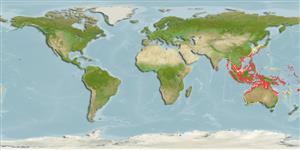>
Ovalentaria/misc (Various families in series Ovalentaria) >
Pomacentridae (Damselfishes) > Pomacentrinae
Etymology: Pomacentrus: Greek, poma, -atos = cover, operculum + Greek, kentron = sting (Ref. 45335).
More on authors: Evermann & Seale.
Environment: milieu / climate zone / depth range / distribution range
Ökologie
seewasser riff-verbunden; standorttreu; tiefenbereich 5 - 60 m (Ref. 7247). Tropical
Western Pacific: Indo-Malayan Archipelago east to the Moluccas and Mentawai Islands, north to Taiwan and the Ryukyu Islands.
Size / Gewicht / Alter
Maturity: Lm ? range ? - ? cm
Max length : 9.0 cm TL Männchen/unbestimmt; (Ref. 9710)
Rückenflossenstacheln (insgesamt): 13; Rückenflossenweichstrahlen (insgesamt): 14-15; Afterflossenstacheln 2; Afterflossenweichstrahlen: 14 - 15.
Adults occur in lagoon, inshore, and offshore reefs (Ref. 9710). Usually seen solitary, often swimming well above substrate (Ref. 48636). Feed on algae, barnacle nauplii, copepods, fish eggs, and small gastropods. Oviparous, distinct pairing during breeding (Ref. 205). Eggs are demersal and adhere to the substrate (Ref. 205). Males guard and aerate the eggs (Ref. 205).
Life cycle and mating behavior
Geschlechtsreife | Fortpflanzung | Ablaichen | Eier | Fecundity | Larven
Oviparous, distinct pairing during breeding (Ref. 205). Eggs are demersal and adhere to the substrate (Ref. 205). Males guard and aerate the eggs (Ref. 205).
Allen, G.R., 1991. Damselfishes of the world. Mergus Publishers, Melle, Germany. 271 p. (Ref. 7247)
IUCN Rote Liste Status (Ref. 130435)
Bedrohung für Menschen
Harmless
Nutzung durch Menschen
Mehr Information
ReferenzenAquakulturAquakultur ProfilZuchtlinienGenetikElectrophoresesVererbbarkeitKrankheitenVerarbeitungNutrientsMass conversion
Tools
Zusatzinformationen
Download XML
Internet Quellen
Estimates based on models
Preferred temperature (Ref.
123201): 25.6 - 29, mean 28 °C (based on 634 cells).
Phylogenetic diversity index (Ref.
82804): PD
50 = 0.5000 [Uniqueness, from 0.5 = low to 2.0 = high].
Bayesian length-weight: a=0.02455 (0.01299 - 0.04638), b=3.00 (2.84 - 3.16), in cm total length, based on LWR estimates for this species & Genus-body shape (Ref.
93245).
Trophic level (Ref.
69278): 3.1 ±0.36 se; based on food items.
Widerstandsfähigkeit (Ref.
120179): hoch, Verdopplung der Population dauert weniger als 15 Monate. (Preliminary K or Fecundity.).
Fishing Vulnerability (Ref.
59153): Low vulnerability (10 of 100).
Nutrients (Ref.
124155): Calcium = 120 [59, 184] mg/100g; Iron = 0.789 [0.472, 1.299] mg/100g; Protein = 18.3 [17.1, 19.4] %; Omega3 = 0.133 [0.079, 0.219] g/100g; Selenium = 27.6 [14.8, 51.1] μg/100g; VitaminA = 95.9 [27.5, 319.9] μg/100g; Zinc = 1.71 [1.15, 2.45] mg/100g (wet weight);
